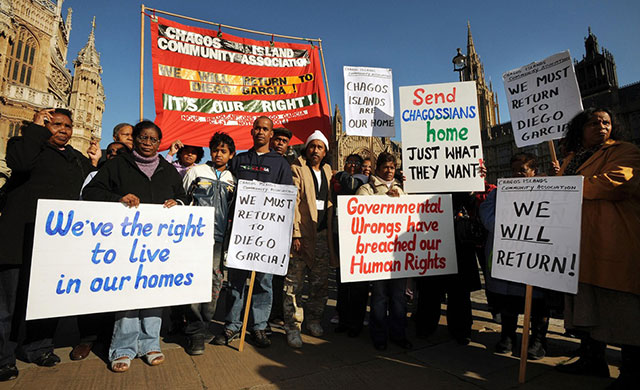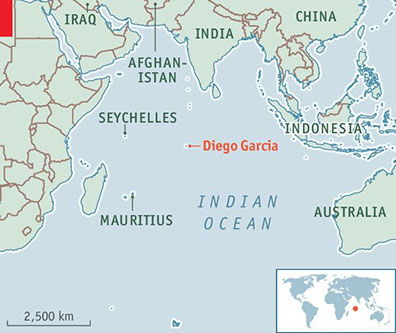No. 14, January 2018
U.S. Imperialism and British Colonialism in the Indian Ocean

Demonstrators protest outside British parliament after court ruled that Chagos islanders could not return to the archipelago, 22 October 2008. (Photo: Matt Dunham/AP)
By Sharpe
In light of the devastation of Puerto Rico, Donald Trump’s announcement that 59,000 Haitians will be deported from the U.S., and his predecessor Barack Obama’s “humanitarian” invasion of Haiti – to name just a few crucial topics – it is important for young revolutionaries to understand the reality and history of colonial and neocolonial oppression. The little-known military base at Diego Garcia is a vivid example.
The maxim that when colonialism dies, it dies a slow death, is particularly true in the case of the Chagos Archipelago. The archipelago, also known as the British Indian Ocean Territory (BIOT), was excised from Mauritius (then a British colony) in 1965. Its largest island, Diego Garcia, has been home to a U.S. military base since 1971. (See map below.) The entire population of the archipelago was coerced into leaving the islands or forcibly removed, with almost 2,500 inhabitants kicked out between 1965 and 1971. The U.S. military base on Diego Garcia is of great geopolitical importance for the British and U.S. imperialists, who wage their racist “War on Terror” in the Middle East, and parts of Africa and South Asia. The archipelago is strategically located in the middle of the Indian Ocean, due south of India’s southern tip, and midway between Madagascar (an island off the coast of Mozambique in south-eastern Africa) and north-western Australia. The base is a staging ground for imperialist attacks in the Middle East, as well as a projection of imperialist power in Africa and South Asia.
 Map showing location of Diego Garcia in the
Indian Ocean. (Map: The
Economist)
Map showing location of Diego Garcia in the
Indian Ocean. (Map: The
Economist)The situation of U.S. imperialism in the Indian Ocean is somewhat like that in the Caribbean, particularly as regards Puerto Rico. Diego Garcia and Puerto Rico are both colonies (the latter being the world’s largest). The former is legally a British colonial possession which has been on lease to the U.S. since 1966. Puerto Rico has served many purposes for U.S. imperialism since the U.S. grabbed it in 1898, most recently as a source of easy profits for Wall Street hedge fund vultures who keep the island in debt peonage. They use its status as a colony to reap massive returns on investment by forcibly depressing wages through the island’s financial dictatorship – the six-member Financial Oversight and Management Board, appointed by then-president Barack Obama in 2016 under the PROMESA Act (see page 13 of this issue).
Puerto Rico’s other main purpose for U.S. imperialism, however, is very much in line with that of Diego Garcia. This is of course the projection of military might in the region. In addition to formerly using the island of Vieques (a small island approximately ten miles east of mainland Puerto Rico) as a Navy bombing range, together with the huge base at Roosevelt Roads on the main island,, the U.S. military maintains the colony as a show of force. This is especially true for the deformed workers state of Cuba, which has defied Yankee imperialism in the Caribbean since the revolution of 1959, as well as the colonial and semi-colonial island nations of the Caribbean. Diego Garcia offers a similar benefit to the imperialists in the Indian Ocean, affording the U.S. and U.K. an “unsinkable aircraft carrier” from which to stage all manner of military aggressions in the region.
The naval base on Diego Garcia was grotesquely nicknamed Camp Justice until 2006 (now referred to as Camp Thunder Cove), but is formally called Naval Support Facility Diego Garcia by the U.S. and Permanent Joint Operating Base (PJOB) Diego Garcia by the U.K. Though Chagos is part of the British Indian Ocean Territory, the U.S. was granted a pro bono lease in 1966 in return for a discount to the tune of $14 million on submarine-launched Polaris missiles. This was a win-win for a British bourgeoisie faced with declining profits which could not afford to operate a military base there on its own, and a militarily-dominant U.S. imperialism then engaged in colonial war against the people of Vietnam.
Formerly part of the British colony of Mauritius, the Chagos Archipelago was excised by the U.K. to form part of the BIOT (which until 1976 also included the islands of Aldabra, Farquhar, and Desroches, that were excised from the then-British colony of Seychelles), three years before Mauritius became independent in 1968. The construction of a military base on Diego Garcia was part of the U.S.-U.K. Mutual Defense Agreement of 1958, a treaty providing for cooperation on nuclear weapons development between the two states. It was a direct response to the Soviet Union’s historic achievement of launching Sputnik-1, the first-ever artificial satellite to orbit Earth. This terrified the imperialists, who hated the fact that the USSR, which despite its Stalinist degeneration still embodied key gains of the 1917 Revolution, could defend itself with nuclear weapons of its own. This is the origin of the so-called “special relationship” between the U.S. and U.K. constantly repeated by bourgeois politicians of both countries.
But to build the military base, the people living there had to be expelled. By 1971, almost all the island had been depopulated. The Chagossians living on Diego Garcia (the largest island in the archipelago) and the outlying islands had either been duped into leaving by the British colonial administration, or had been forcibly expelled under threat of U.S. military aggression. People were not offered compensation or even asked if they wanted to remain. This was a process punctuated by deceit, terror and violence. Some Chagossians, upon travelling to Seychelles or Mauritius for work or familial reasons, were refused return passage. The ships which had carried people back and forth between these islands only went in one direction, transporting people from Chagos but not to it. Those looking for return voyages were told that no ships were going back. This marooned a portion of the Chagossian population in either Mauritius or Seychelles. Those who refused to leave were in for something worse.
Once the U.S. military had arrived in 1971 and since Diego Garcia still had a sizable population, plans were put into effect almost immediately, in conjunction with the British, to push out the rest of the Chagossians. These plans included a campaign of terror designed to frighten the population into submission. An infamous tactic was to herd the pet dogs of Chagossians into make-shift gas chambers, and force their owners awaiting deportation to watch them be killed. A spokesman for the British Foreign Office said “it was the most humane way of dealing with them [the dogs].” Some Chagossians were even forced from their homes at gunpoint by U.S. and U.K. military personnel. Those on Diego Garcia, if not taken directly to Mauritius or Seychelles, went to either Peros Banhos or Salomon (two smaller atolls in the archipelago), and were then deported a second time to either Mauritius or Seychelles. The imperialists allowed them the “choice” of which country they were to be deported to – a supposed act of magnanimity.
The military base on Chagos has been very useful in projecting imperial power in the Indian Ocean and surrounding regions. A 2012 essay in a joint foreign policy journal of the British and Indian bourgeoisies made this explicit:
“The island facilitates US power projection through the prepositioning of army and marine corps brigade sets, long-range bomber operations, the replenishment of naval surface combatants, and the strike and special operations capabilities of guided-missile submarines that can call at the atoll’s wharf.…
“Historically the US has been able to deter further military action by…states in the region with only symbolic ‘tripwire’ forces, such as the elements of the 82nd Airborne that were deployed to Saudi Arabia in the immediate aftermath of Saddam Hussein’s 1990 invasion of Kuwait.”
– “A Neo-Nixon Doctrine for the Indian Ocean: Helping States Help Themselves,” Strategic Analysis, 8 May 2012
It was a major staging ground for the imperialist wars in Afghanistan and Iraq. It also serves as an outpost against the deformed workers state of China, which receives 85% of its energy imports via Indian Ocean trade routes.
The CIA and U.S. military also used the base as a “black site” during their program of “extraordinary rendition” in the George W. Bush era. This was a practice in which the U.S. government (or CIA contractors) would kidnap people and move them from country to country for the purposes of detention and torture. Additional “black sites” were set up in Syria, Jordan, Egypt, Morocco, and other countries. As part of this program, “rendered” individuals from across the globe (Europe, Asia, Africa, the Middle East) were taken to Chagos and brutally tortured, before being hauled off to somewhere else.
The British, ostensibly not wanting to appear quiescent as torture was carried out on their territory, asked the U.S. to cease using the Diego Garcia base for this purpose, a request to which the U.S. military acquiesced, transferring prisoners to other black sites or the Guantánamo Bay Naval Base. The truth is, the British government were full partners in the endeavor, but denied it for years. In 2005, former Foreign Secretary Jack Straw called the notion a “conspiracy” and said that “there simply is no truth in the claims that the United Kingdom has been involved in rendition full stop.” But in 2008 they reversed course, with then-Foreign Secretary David Miliband admitting they had lied all along: “contrary to earlier explicit assurances that Diego Garcia had not been used for rendition flights, recent US investigations have now revealed two occasions, both in 2002, when this had in fact occurred.”
The British government then tried to cover up its own role in the program, making the incredible claim that records relating to flight departures and arrivals on Diego Garcia from 2002 were “incomplete due to water damage.”
Diego Garcia is one of many instances where imperialist domination is based on colonial subjugation ... and expulsion. In Puerto Rico the fight against imperialism means fighting to break the chains of colonialism and win independence as part of a socialist federation of the Caribbean. On Diego Garcia, only the defeat of U.S. imperialism throughout the region would allow the displaced Chagossians to democratically choose whether and how they wanted to return. Either way, it will take world socialist revolution to get rid of the imperialist criminals once and for all. ■
